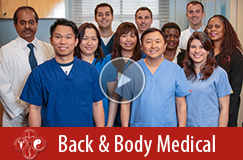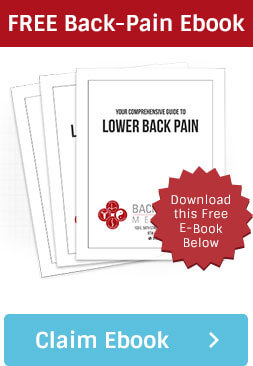CrossFit Open 17.1 Recovery
With 17.1 in the books for the Open we’re going to talk about what exercises and stretches should be done to maximize your recovery so that you’re ready 17.2 on this Back & Body video. Dr. Dave Perna here with Back & Body your combined care approach of chiropractic, physical therapy and acupuncture treating patients in Midtown, Manhattan in New York City on 58th and Lexington as well as in New Jersey on US Route 22 East in Springfield, New Jersey servicing the patients of Union County including Summit, Springfield, Cranford, Union, Westfield, and Scotch Plains.
With the Open upon us, a lot of people had just finished 17.1 and as predicted as soon as we saw what 17.1 exercises were, I immediately thought that this was going to be taxing on most people’s low back. A barbell off the floor is a little higher up than a dumbbell and that little extra reach downward might be more taxing on people who are limited in mobility in the hips and hamstrings, particularly picking up from the floor in that position. A kettle bell is roughly the same height as a barbell and that would’ve been a very similar motion, however with the dumbbell being so low to the ground, a lot of people as they got further into the workout started breaking their position in their low back and arching more, so what we heard right away from most people was that their low backs were bothering them, they had tightness and stiffness.
It’s important to understand what overexertion pain is or muscle soreness is and what joint pain is. It’s pretty easy at this point if you’re flexing your low back and feel tightness outside the spine in the muscles, that’s a good indication of late onset muscle soreness from a workout that was too intense, that’s okay. However, if you have a history of low back pain and if you’ve had low back pain before in the joints and you’re having additional pain in the joints, there’s a good chance you should seek professional help sooner than later so that you’ll be ready for more exercises down the line. That said, we’re going to have a list of exercises that we are suggesting you do. It’s important to remember that even though you feel like you can’t even get off the couch today because you’re so sore, you have to. Your metabolic conditioning needs to stay high for 17.2, we don’t know what it’s going to be but most open workouts require a decent amount of metabolic conditioning.
CrossFit Recovery Exercises in NYC
You can’t just rest until Wednesday or Thursday and expect to be okay, you have to do some light level metabolic conditioning. If you look at most professional athletes who do a series of events one after another, they do what’s called active rest. The Tour de France comes to mind when you talk about a lot of books that discuss the type of care various professionals receive during the Tour de France discussed on the downtime they did a lot of active rest. You also saw it in the Olympics, especially with some of the higher end athletes in the swimming competitions who used to do a lot of active rest in the lap pools right after one competition to get the blood flow and get the lactic acid out of the muscles so they’re ready for their next race.
With this knowledge, you should know that next time you’re done with a competition don’t just lay on the floor until you feel better, get up and walk out to head home, you should do some active rest before you leave, even if it just means walking around the block before you head into your car. A lot of the higher end athletes in our own gym do some assault bike right after, and I thought that was a great idea just to keep the blood moving and get the lactic acid out of the muscles that were hurting the most. So what type of active rest activities can you do? or active recovery activities can you do? We have a few. The first thing that comes to mind that would be very easy is rowing. Now none of these activities I’m going to suggest are high intensity.
If you row a 130 500 meters you shouldn’t be anywhere near that during your active recovery. It should be somewhere around the 2 minute range, and you should do about 500 meters or closer to 5 minutes of active recovery. Something like a light row for 5 minutes would be a great idea for rowers not available an assault bike would also be a good idea for 5 minutes just lightly pedaling and using the upper arms at the same time to get the heart rate moving so the blood flows to the muscles and gets all that bad by product of all of your exercises out. The last thing I think would be a good idea would be some light jump rope to work on your skill because you never know if it might show up again or some single under jump rope just get moving.
That would probably be my last choice of the 3 on what activity to get the heart rate moving today. It doesn’t have as much ability to work some of the upper thigh muscles and back muscles as the rowing would. The other activities are some light sets of exercise. The first thing I’d recommend would be a prone extension, maybe 3 sets of 10 using your own body weight. Things like the superman activity, 3 sets of 10 would be a good idea. That or some light kettle bells if you typically swing a 70 pound kettle bell, something like the fifties or below, 3 sets of 10 with very easy motion going through it with lots of rest between sets would be a good idea. If you’re doing a 35 pound kettle bell, then find the lightest kettle bell and use a dumbbell that’s even lighter in the 12-15 pound range. This isn’t supposed to be exertional as much as just working the muscles a little bit. The last thing I would recommend is if you’re gym has a verse hyper extension, it might be a little more advanced and that activity might be a better idea for the higher end athletes in your gym or experienced a history of low back pain and knows reverse hyper extension is an activity that often helps them with relief of low back. If you don’t have a reverse hyper extension, we’re going to show you a video that will show you how to do it on GHD machine. The last thing you should consider doing are some light stretches both the hamstrings and low back . We’re going to show you some videos of the stretches for the hamstring as well as the low back. If you have any questions, you can leave comments down below and I’ll be glad to answer them for you. Good luck in your workouts this week leading up to 17.2.
This is a basic stretch for the low back, the key for this you have to tuck in the pelvis instead of reverse arching your low back, you’re creating what they call a camel back position that helps stretch out the QL muscles of the low back. This next stretch can be done anywhere, you just need to kneel down and arch your low back and stretch out the QL muscles in this position. You can then step it or walk it to the left or right to get one muscle better than the other. This is an excellent other stretch to be done. Remember all of these stretches should be done after some light metabolic activities such as rowing.
The final stretch after some light metabolic activity is the hamstring stretch. This can be done in the supine position with the back in the neutral state, lifting one leg at a time to get a good stretch behind the leg. The next light exercise we ask you to do for the low back would be to do supermans or some extension activity. This is done either on the floor or on a mat, just bringing your legs and arms up at the same time.
This is the last exercise we recommend and this is for a more advanced person who might have a strong low back to begin with. This is a reverse hyper extension. If you do not have a reverse hyper extension machine, you see how we can do it using just a simple GHD. You can use bands or just the weight of your legs for a good activity to activate those low back muscles and get the soreness out of them. So there you have it, our stretches and recommended activities to recover a little bit more appropriately for 17.1, trying to get rid of some of that soreness so that you can start getting back in the gym and working hard towards reaching your goals for 17.2. If you have any questions, please leave comments below. We’ll see you next week when we discuss recovery activities for 17.2
















